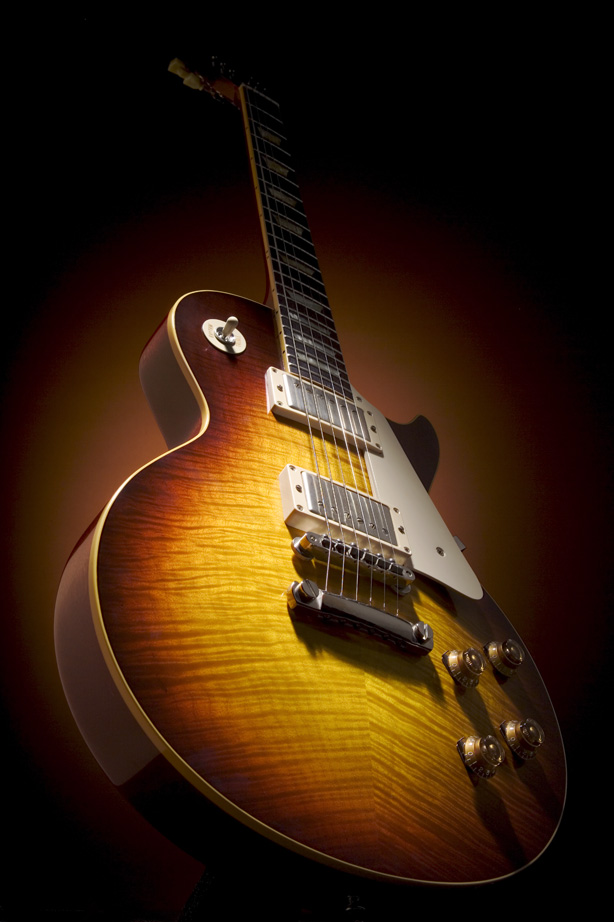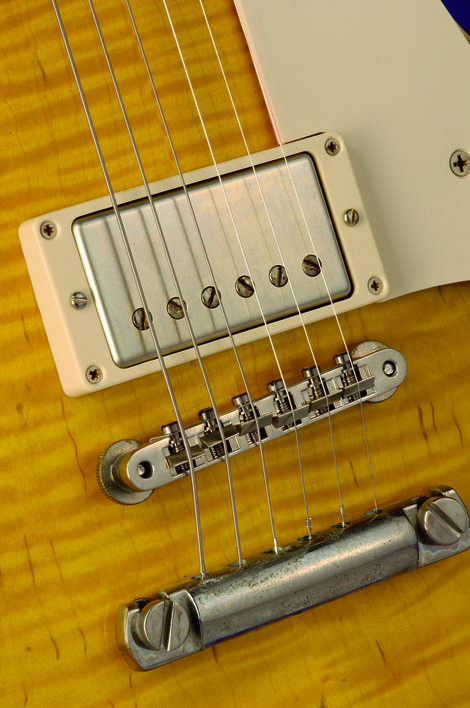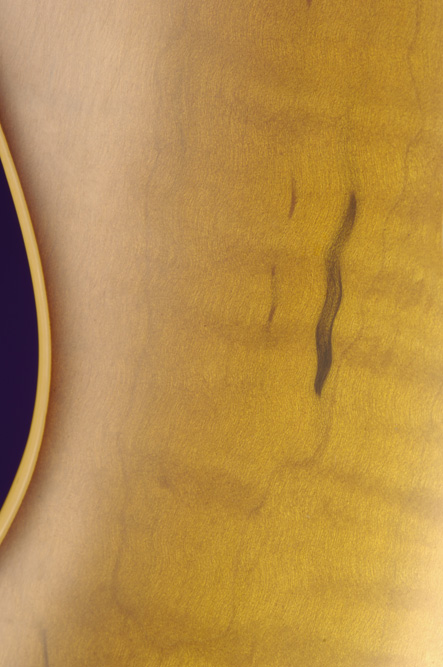MusicRadar Verdict
The '59 Standard has its flaws - literally, on its flamed maple cap - but otherwise it´s a most splendid example of an instrument that´s come to represent electric guitar tone at its finest. Gibson's Reissues are getting better and closer with each revision. However, here´s one final thought: will the £10,000 Honduran mahogany and Brazilian rosewood Standard ever surface? Our bets are already placed…
Pros
- +
Outstanding looks and vibe, stunning tones
Cons
- -
Huge price, some will find the finish idiosyncracies unacceptable.
MusicRadar's got your back



Gibson has been making 'official' reissues of its Les Paul range since 1983. Even before this, there was the occasional attempt, as with 1980's Standard 80 and Standard 80 Elite, which looked good but were still miles away from the original specifications.
There had always been the occasional limited runs built for canny US dealers, who recognised a demand that Gibson wasn't fulfilling.
People like guitar shop owners Chris Lovell in Memphis and Jimmy Wallace in Dallas asked Gibson for specific details to be included on strictly limited retail runs, such as flame maple tops, narrower headstocks and correct cutaway binding.
In the intervening 20 years or so, the instruments have got closer to that Holy Grail - in this case, the sunburst Standards built between 1957 and 1960. This latest incarnation, carrying the banner Vintage Original Spec, aims to up the ante even further.
Not only are there one or two added vintage features, but the finish has also been given the look of a well-loved original, and so they're guaranteed to elicit a gasp of awe.
It's certainly a sight to behold. That initial glimpse really does fool you into thinking you've just spied £100,000 of vintage guitar.
Gibson has worked on a way of dulling the cellulose finish to emulate the patina that comes from years of exposure to the elements, including smoky rooms, changes in atmosphere and temperature, and not forgetting good old sweat.
The nickel-plated parts are likewise mildly aged using a tarnishing process that adds real character - as if a '59 Standard needs more character!
Some of the minor changes recently brought to the Reissue range include: a headstock that tapers in thickness; more accurately shaped and coloured 'crown' fingerboard inlays; lightweight aluminium tailpiece bar; thinner rhythm/treble toggle switch ring; thinner jack plate; original-style CTS pots; and old-fashioned 'bumblebee' capacitors.
These small things make a lot of difference to fans of the early models and, whether they improve the instruments or not, they're all very welcome additions.
A more significant change to the Standard came in 1959, with the introduction of jumbo frets. In 1959, the term 'jumbo' really meant slightly wider and taller, and not the kind of railway sleepers we see on rock guitars today.
But it did mean the Les Paul's fingerboard - with the help of a neck slimmed down from the baseball bat of the previous year - was much more playable by those who used finger vibrato and string bends.
History reminds us that this instrument found its way into the hands of players like Eric Clapton and Michael Bloomfield. With these guitars, they instigated the kind of sustain and distortion that we take for granted in rock and blues today.
This sound prompted huge demand for the instrument, but by that time it was unavailable new, Gibson having discontinued it in favour of the SG shape. That was the birth of the vintage guitar phenomenon, and the reason these Reissues exist at all.
One thing Gibson hasn't done, and which true fans and collectors really wish they would, is re-introduce Brazilian rosewood fingerboards and Honduran mahogany backs and necks. It looks like the usual Indian rosewood and probably Brazilian mahogany here.
Of course, there are mammoth issues regarding protected species (which both these timbers are) and the certificates needed to export and import such wood, not to mention the moral dilemma faced by prospective purchasers. This makes it hard to see a solution to this problem, but other manufacturers do it, so why not Gibson? It's what the buffs want, above almost everything else now.
Quality-wise, it's a hard call with instruments of this price. Contrary to myth, Gibson guitars were never perfectly built and flawlessly finished. Gibson's Custom Shop has actually reinstated certain finishing methods that fly in the face of modern ideals.
For instance, it doesn't sand and buff the sides of the headstock to a perfectly flat finish, so it has a sort of end-grain 'orange peel' look. However, this was how they always were, and whether or not it's an anachronism too far, it's right for the guitar.
Another factor that will please some and irk others is the number of imperfections within the maple top itself. We like the fact that the surface isn't ridiculously flamed, because hardly any were.
However, it also has various dark-coloured 'flaws' within the maple itself, and while you may think that greater care should be taken with the choice of timber for guitars of this price, this reviewer has played Eric Clapton's 1960 Les Paul and it shows very similar imperfections.
There's no definitive answer to such questions, other than that if you want total perfection, go to Anderson or PRS. Of course, they don't make Les Paul reissues, and overall we feel that Gibson lovers will prefer the authentic look; non-Gibson fans just won't care.
Thankfully, details like fret finishing, neck shaping and playability have all received the full weight of the Custom Shop's expertise. Action as supplied was perfect, being low enough for speed and fretting ease, but with enough space to get your fingers behind the strings for bending.
Meanwhile, the neck's biggish '59 profile is becoming something of a must-have among players who realise that they're more comfortable to play.
Sounds
It's interesting to sit with the guitar in your hands and assess how the '59 really sounds. Les Pauls are often sharper-toned than we think, because as well as the low-end thump, there's a soft treble that combines with it to create a really vocal quality.
This manifests itself best through cranked-up valve amps with low front-end gain, where the component parts of the tone - both guitar and amp - become almost transparent.
Les Pauls definitely work best this way, with Gary Moore levels of drive about as far as you want to go before the tone starts to disappear under the mush.
Many of the tones we associate with vintage Les Pauls are far cleaner than you think, such as those of the Bluesbreakers, Bloomfield, Kossoff and so on. Even Slash's overdrive is quite moderate!
The neck pickup, a BurstBucker 1, loves medium drive and rewards you with a rich, chocolatey sound that you can back the tone off for 'woman tone' or wind up for those Slash or Gary Moore moments.
Flip the switch to the bridge (BurstBucker 2) and you find a focused tone that asks for a tad more drive to make it sing. Cranking it up high through a Cornford Hurricane produces some brooding but articulate tones that scream vintage Clapton.
Speaking of whom, the ever-present Crossroads tone can be instantly had with both 'buckers on and the neck one backed off to seven, which is very convincing and, musically, very satisfying indeed.
MusicRadar is the number 1 website for music makers of all kinds, be they guitarists, drummers, keyboard players, djs or producers...
GEAR: We help musicians find the best gear with top-ranking gear round-ups and high- quality, authoritative reviews by a wide team of highly experienced experts.
TIPS: We also provide tuition, from bite-sized tips to advanced work-outs and guidance from recognised musicians and stars.
STARS: We talk to musicians and stars about their creative processes, and the nuts and bolts of their gear and technique. We give fans an insight into the actual craft of music making that no other music website can.
“Every note counts and fits perfectly”: Kirk Hammett names his best Metallica solo – and no, it’s not One or Master Of Puppets
Ranked: Bon Iver's albums, from Sable, Fable to For Emma, Forever Ago
“Its mission is simple: unleash the power of any amplifier or line-level source without compromise”: Two Notes promises a “watershed” in tube amp control with the Torpedo Reload II










